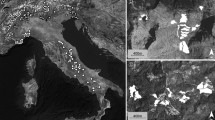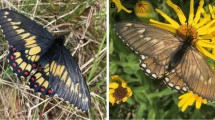Abstract
Background
Effective conservation of specialised, endangered species depends on the knowledge of all vital resources they require within species’ lifetime. The butterfly Chazara briseis is endangered throughout Europe, especially so in all states north from the Alps. It depends on large areas of open steppe grassland with short and sparse turf.
Aim
To identify resource use by adult C. briseis butterflies in relation to vegetation structure within its sites.
Methods
We re-analysed mark-recapture data from the last Czech metapopulation, inhabiting a chain of volcanic hills in Ceske Stredohori highlands and hosting 2000 adults in 2006. We related adult activities observed prior to captures to visually assessed vegetation structures and land cover types obtained from aerial photographs. Additionally, we used land cover types to explore the adults’ home ranges and to compare capture points with randomly selected points.
Results
The butterflies displayed clearly structured diurnal activity with nectaring from morning to noon and courtship activities and egg-laying in the afternoons. Both sexes used short-sward patches (egg laying, patrolling), but also patches with taller, flower-rich vegetation (mating, nectaring). These results were corroborated using land cover types, however, with much lower explanatory power. Lifetime utilisation of land cover types (home ranges) differed between sexes, females utilised more shrubby and longer-sward areas than males. Randomly selected points within the sites significantly differed from capture points, the latter contained more open, either short or tall grassland patches.
Implications for Insect Conservation
Management of inhabited sites must provide open, short-sward patches alternating with flower-rich taller sward and shrubby patches.



Similar content being viewed by others
References
Asher J, Warren M, Fox R, Harding P, Jeffcoate G, Jeffcoate S (2001) The Millenium Atlas of butterflies in Britain and Ireland. Oxford University Press, Oxford
Balmer O, Erhardt A (2000) Consequences of succession on extensively grazed grasslands for central European butterfly communities: Rethinking conservation practices. Conserv Biol 14:746–757
Beneš J, Konvička M, Dvořák J, Fric Z, Havelda Z, Pavlíčko A, Vrabec V, Weidenhoffer Z (2002) Motýli České rebubliky: Rozšíření a ochrana I, II/Butterflies of the Czech republic: Distribution and conservation I, II. SOM, Praha
Berger-Tal O, Blumstein DT, Carroll S, Fisher RN, Mesnick SL, Owen MA, Saltz D, St Claire CC, Swaisgood RR (2016) A systematic survey of the integration of animal behavior into conservation. Conserv Biol 30:744–753
Binzenhofer B, Schroder B, Strauss B, Biedermann R, Settele J (2005) Habitat models and habitat connectivity analysis for butterflies and burnet moths—the example of Zygaena carniolica and Coenonympha arcania. Biol Conserv 126:247–259
Brakefield PM (1982) Ecological studies on the butterfly Maniola jurtina in Britain. 1. Adult behavior, microdistribution and dispersal. J Anim Ecol 51:713–726
Caro T (2007) Behavior and conservation: a bridge too far? Trends Ecol Evol 22:394–400
Chytrý M, Kučera T, Kočí M, Grulich V. Lustyk P (eds) (2010) Katalog biotopů České republiky. Ed. 2. Agentura ochrany přírody a krajiny ČR, Praha.
Clarke MF (2008) Catering for the needs of fauna in fire management: science or just wishful thinking? Wildl Res 35:385–394
Cremene C, Groza G, Rakosy L, Schileyko AA, Baur A, Erhardt A, Baur B (2005) Alterations of steppe-like grasslands in Eastern Europe: a threat to regional biodiversity hotspots. Conserv Biol 19:1606–1618
Dennis RLH (2010) A resource-based habitat view for conservation: butterflies in the British landscape. Wiley-Blackwell, Chichester
Dennis RLH, Shreeve TG, Van Dyck H (2003) Towards a functional resource-based concept for habitat: a butterfly biology viewpoint. Oikos 102:417–426
Dreisig H (1995) Thermoregulation and flight activity in territorial male graylings, Hipparchia semele (Satyridae), and large skippers, Ochlodes venata (Hesperiidae). Oecologia 101:169–176
ESRI (2011) ArcGIS desktop: release 10. Environmental Systems Research Institute, Redlands
Garcia-Barros E (1988) Delayed ovarian maturation in the butterfly Hipparchia semele as a possible response to summer drought. Ecol Entomol 13:391–398
Garcia-Barros E (2000) Comparative data on the adult biology, ecology and behaviour of species belonging to the genera Hipparchia, Chazara and Kanetisa in central Spain (Nymphalidae: Satyrinae). Nota Lepidopterol 23:119–140
Jakubikova L (2012) Autekologie kriticky ohroženého okáče metlicového (Hipparchia semele L.) v CHKO Český kras [Autecology of critically endangered Grayling (Hipparchia semele L.) in Bohemian Karst PLA]. Thesis. Czech University of Life Sciences Prague
John V, Andres M, Skala P, Cip D (2018) Regionální akční plán pro okáče skalního (Chazara briseis). [Regional species action plan for Chazara briseis.] Msc., depon. AOPK ČR, RP České středohoří
Kadlec T, Benes J, Jarosik V, Konvicka M (2008) Revisiting urban refuges: changes of butterfly and burnet fauna in Prague reserves over three decades. Landsc Urban Plan 85:1–11
Kadlec T, Vrba P, Kepka P, Schmitt T, Konvicka M (2010) Tracking the decline of the once-common butterfly: delayed oviposition, demography and population genetics in the hermit Chazara briseis. Anim Conserv 13:172–183
Kadlec T, Vrba P, Konvicka M (2009) Microhabitat requirements of caterpillars of the critically endangered butterfly Chazara briseis (L.) (Nymphalidae, Satyrinae) in the Czech Republic. Nota Lepidopterol 32:39–46
Kaspar A (1938) Denní motýli Kosíře [Butterflies of the Kosíř Hill]. Časopis Vlasteneckého Spolku Musejního (Olomouc) 51:154–162
Kleckova I, Klecka J (2016) Facing the Heat: Thermoregulation and behaviour of lowland species of a cold-dwelling butterfly genus, Erebia. PLoS ONE 11:e0150393
Konvicka M, Benes J, Cizek O, Kopecek F, Konvicka O, Vitaz L (2008) How too much care kills species: Grassland reserves, agri-environmental schemes and extinction of Colias myrmidone (Lepidoptera : Pieridae) from its former stronghold. J Insect Conserv 12:519–525
Konvicka M, Kuras T (1999) Population structure, behaviour and selection of oviposition sites of an endangered butterfly, Parnassius mnemosyne, in Litovelske Pomoravi, Czech Republic. J Insect Conserv 3:211–223
Lebeau J, Wesselingh RA, Van Dyck H (2016) Floral resource limitation severely reduces butterfly survival, condition and flight activity in simplified agricultural landscapes. Oecologia 180:421–427
Maes D, Bonte D (2006) Using distribution patterns of five threatened invertebrates in a highly fragmented dune landscape to develop a multispecies conservation approach. Biol Conserv 133:490–499
Maes D, Ghesquiere A, Logie M, Bonte D (2006) Habitat use and mobility of two threatened coastal dune insects: implications for conservation. J Insect Conserv 10:105–115
Maes D, Jacobs I, Segers N, Vanreusel W, Van Daele T, Laurijssens G, Van Dyck H (2014) A resource-based conservation approach for an endangered ecotone species: the Ilex Hairstreak (Satyrium ilicis) in Flanders (north Belgium). J Insect Conserv 18:939–950
Mevi-Schutz J, Erhardt A (2003) Effects of nectar amino acids on fecundity of the wall brown butterfly (Lasiommata megera L.). Basic Appl Ecol 4:413–421
Moucha J, Prochazka F (1962) Motýli [Butterflies]. SNDK, Prague
Pamperis LN (1997) The butterflies of Greece. Bastas-Plessas Graphic Arts SA, Athens
Pinzari M (2009) A comparative analysis of mating recognition signals in graylings: Hipparchia statilinus vs. H. semele (Lepidoptera: Nymphalidae, Satyrinae). J Insect Behav 22:227–244
Pinzari M, Sbordoni V (2013) Species and mate recognition in two sympatric Grayling butterflies: Hipparchia fagi and H. hermione genava (Lepidoptera). Ethol Ecol Evol 25:28–51
Samietz J, Berger U (1997) Evaluation of movement parameters in insects—Bias and robustness with regard to resight numbers. Oecologia 110:40–49
Slamova I, Klecka J, Konvicka M (2011) Diurnal behavior and habitat preferences of Erebia aethiops, an aberrant lowland species of a mountain butterfly clade. J Insect Behav 24:230–246
Slamova I, Klecka J, Konvicka M (2013) Woodland and grassland mosaic from a butterfly perspective: habitat use by Erebia aethiops (Lepidoptera: Satyridae). Insect Conserv Diver 6:243–254
Smith AG, Shreeve TG (1993) The systematics, behaviour and habitats of the Madeiran grayling (genus Hipparchia: Lepidoptera, Satyrinae). Bol Mus Munic Funchal 279–283
Ter Braak CJF, Smilauer P (2013) Canoco 5, Windows release (5.00). Available from: www.canoco5.com
Tropek R, Cizek O, Kadlec T, Klecka J (2017) Habitat use of Hipparchia semele (Lepidoptera) in its artificial stronghold: necessity of the resource-based habitat view in restoration of disturbed sites. Pol J Ecol 65:385–399
Turlure C, Schtickzelle N, Dubois Q, Baguette M, Dennis RLH, Van Dyck H (2019) Suitability and transferability of the resource-based habitat concept: a test with an assemblage of butterflies. Front Ecol Evol 79:127
Uchida K, Ushimaru A (2014) Biodiversity declines due to abandonment and intensification of agricultural lands: patterns and mechanisms. Ecol Monogr 84:637–658
van Swaay CAM, Cuttelod A, Collins S, Maes D, Munguira ML, Sasic M, Settele J, Verovnik R, Verstrael T, Warren MS, Wiemers M, Wynhoff I (2010) European red list of butterflies. Publications Office of the European Union, Luxembourg
Vanreusel W, Van Dyck H (2007) When functional habitat does not match vegetation types: a resource-based approach to map butterfly habitat. Biol Conserv 135:202–211
Vlasanek P, Fric ZF, Zimmermann K, Novotny D, Cizek O, Kleckova I, Vrba P, Kadlec T, Konvicka M (2018) Do butterfly activity data from mark-recapture surveys reflect temporal patterns? J Insect Behav 31:385–401
Vrba P, Kadlec T, Konvicka M (2009) Přežije okáč skalní v České republice? [Will the Herming butterfly survive in the Czech Republic?] Ziva 57:30–33
Wiklund C (1982) Behavioral shift from courtship solicitation to mate avoidance in female ringlet butterflies (Aphantopus hyperantus) after copulation. Anim Behav 30:790–793
Author information
Authors and Affiliations
Corresponding author
Additional information
Publisher's Note
Springer Nature remains neutral with regard to jurisdictional claims in published maps and institutional affiliations.
Supplementary information
Below is the link to the electronic supplementary material.
10841_2020_287_MOESM1_ESM.xlsx
Electronic supplementary material 1 Spreadsheet table showing details of controlling the CCA analyses relating activities of Chasara briseis butterfly, as recorded during a mark-recapture study, to vegetation structures and land covers within its sites. In the left columns (“model terms not controlled for variance inflation factor”), variables listed in bold very intercorrelated with others. In the right columns (“model terms after control for variance inflation factors”), it is apparent that all intercorrelated variables were removed from the final models listed in Table 1. (XLSX 14 kb)
Rights and permissions
About this article
Cite this article
Vrba, P., Grill, S., Kadlec, T. et al. How do adults of the critically endangered hermit butterfly (Chazara briseis) utilise their habitat? (Lepidoptera, Satyrinae). J Insect Conserv 25, 39–48 (2021). https://doi.org/10.1007/s10841-020-00287-3
Received:
Accepted:
Published:
Issue Date:
DOI: https://doi.org/10.1007/s10841-020-00287-3




